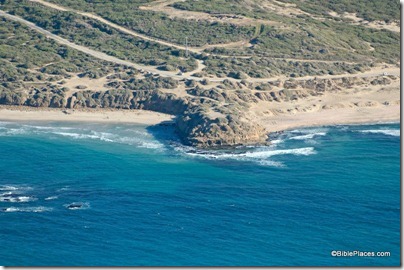A 600-lb metal anchor from the Byzantine period has been discovered off the coast south of Tel Aviv. The find led investigators to two others in the area. Photos are available from the IAA in a zip file. The Sound the Shofar exhibition opened last week in Jerusalem with more than 140 of the horns on display at the Bible Lands Museum. The story includes a two-minute video. The Jerusalem Post has more information about Google Street View in Jerusalem, Tel Aviv, and Haifa. Wayne Stiles takes readers on a visit to Shiloh, the longtime home of the tabernacle. The Archaeology of Libya is discussed in this week’s radio program at the Book and the Spade. (Here’s the direct link to the mp3 file). ATS Pro Terra Sancta has plans to renovate “the Holy Place of Sebastia.” I certainly support improving the conditions at the ancient city of Samaria, though it strikes me as odd to consider as holy the place where Ahab built a temple for Baal worship and Herod built another for the worship of the Roman emperor. An inscription in Aramaic and Greek on a stone lintel has been discovered in the area of ancient Sepphoris. The report is in Hebrew and includes a photograph. A Roman-era style bathhouse was constructed in the middle of a Early Islamic period fortress, say archaeologists excavating at Yavneh-Yam on Israel’s coast. HT: Joseph Lauer, Jack Sasson  Yavneh-Yam
Yavneh-Yam
Wednesday Roundup
- Tagged Discoveries, Galilee, Jerusalem, Museums, Samaria, Technology, Weekend Roundup
Search
About the BiblePlaces Blog
The BiblePlaces Blog provides updates and analysis of the latest in biblical archaeology, history, and geography. Unless otherwise noted, the posts are written by Todd Bolen, PhD, Professor of Biblical Studies at The Master’s University.
Subscribe
Tags
10th Century
American Colony Photos
Analysis
Antiquities Trade
Dead Sea
Dead Sea Scrolls
Discoveries
Egypt
Excavations
Forgery
Galilee
Greece
Holidays
Israel's Coast
Italy
Jerusalem
Jezreel Valley
Jordan
Jordan Rift
Judah
Lebanon
Lectures
Mediterranean Islands
Mesopotamia
Museums
Negev
New Exhibits
Persia
Philistines
Photo Resources
Picture of the Week
Pseudo-Archaeology
Resources
Sad News
Samaria
Shephelah
Syria
Technology
Temple Mount
Tomb of Jesus
Tourism
Travels
Turkey
Weather
Weekend Roundup
Links
Notice
As an Amazon Associate we earn from qualifying purchases. In any case, we will provide honest advice.
2 thoughts on “Wednesday Roundup”
About Sebastia: I am taking people there on a fairly regular basis, and the work that ATS is sponsoring is not on the ancient tel but in the nearby old village core. There, some rather impressive excavation and restoration work has been carried out, on remains ranging from the Roman period to medieval times. Many people would be surprised to discover that there is a huge Crusader cathedral, long known and fairly well preserved, fronting the village square. Sebastia also now boasts an ATS-sponsored guesthouse, created within restored historic structures, which can accommodate small numbers of visitors. Granted, designation of a site as a "holy place" can be quite subjective, but it was "holy" enough to capture the attention of both Byzantine Christians and the Crusaders, the main connection apparently being the supposed final resting place of John the Baptist. In the end, everyone defines their own "holy", I suppose, and so many times a longstanding, imposed meaning simply trumps reality!
Tom – thank you for the clarification and information. I've been to the Byzantine and Crusader churches but still find humor in how such a place was found to be holy by Christians.